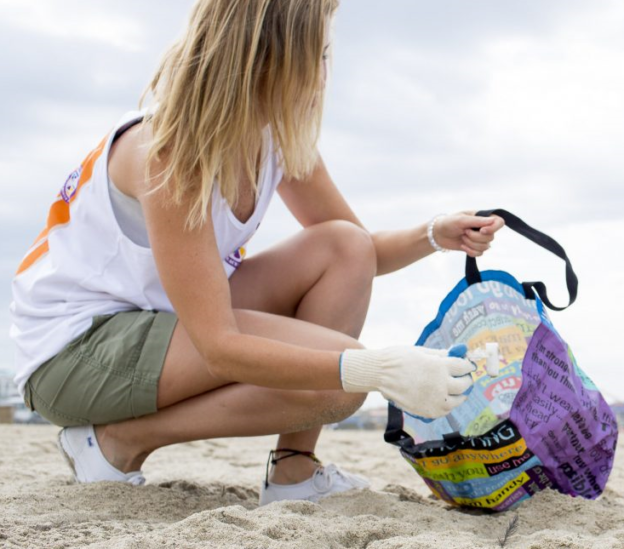Rio Tinto (RT) has finally shared a report from a field investigation in which the company concedes that partner QIT Minerals Madagascar (QMM) mining activities extended into the adjacent Lake Besaroy during the construction of its so-called “berm”.
A buffer zone breach was first raised in The Ecologist in 2017 and a study of the extent of the violation, commissioned by the Andrew Lees Trust (ALT UK), was published in 2018. RT promised the ALT UK last October that it would share its own findings.
Mine tailings
The berm was put in place to contain mine waste from entering the adjacent lakes and waterways. The company admits that this berm was constructed using mine tailings.
The mine tailings contain monazite, which contains radionuclides (uranium-238 and thorium-232). As a result, mine tailings would normally be buried at depths of approximately 15m according to Rio Tinto/QMM (Swanson, 2019).
The fact that mine tailings have been used for surface construction of the berm where the breach has occurred, means that they have entered the adjacent Lake Besaroy with the risk of toxic effects on local water sources.
Accidents happen
Rio Tinto/QMM is claiming the breach was an “unintended occurrence”. An accident by any other name requires serious attention and, when necessary, any remedial measures.
Rio Tinto’s admission arrives just ahead of the release of the Andrew Lees Trust’s Independent Radioactivity Review conducted by Dr Stella Swanson, a radioactivity specialist with over thirty-five years of industry experience.
Using the only available data from QMM, Swanson’s study has identified elevated uranium levels in the local water as high as 50 times the World Health Organisation (WHO) guidance for drinking water quality in some places.
In its response to the findings, Rio Tinto/QMM claims the water has “naturally elevated levels of uranium” due to the pre-existing high background radiation levels in the area.
However, there is insufficient data to clarify what is natural background level and what is QMM related, in order to substantiate their assertion.
Indeed, Swanson’s review highlights serious failings in QMM’s monitoring of radionuclides in the environment, and the resulting uncertainty enough to “trigger additional investigation”.
In particular, Swanson’s study finds QMM’s lack of monitoring of ingestion pathways such as water, soil, and fish, to be “unacceptable”.
Direct impacts
The buffer zone’s purpose is to protect the local waterways from harmful impacts of mining activity; any breach can have a direct impact on local people.
There are some 15,000 people living around the Mandena mine site area and according to available data,only one quarter of all households in the Mandena area were reported to have access to drinking water in 2009 (ATW 2009).
This means a sizeable proportion of the population is harvesting water directly from untreated water bodies.
Local people in rural Anosy are entirely dependent on local natural resources for their survival and livelihoods. The waterways and lakes next to the mine are also used for fishing, washing and gathering reeds for weaving.
Therefore, rather than dismiss the concerns around uranium levels in the water, the Swanson review points to the need to identify and manage the source of toxicity.
It also encourages Rio Tinto/QMM to provide safe drinking water for local people in the communities around the mine site.
Local people
The recommendation comes at a time when civil society in Anosy has been concerned about and pressing for drinking water.
Following local TV coverage in January that reported dead fish in Lake Ambavarano, situated adjacent to Lake Besaroy and the QMM mine, a local civil society platform demanded water testing by the National Centre of Research for the Environment (CNRE), a state body in the Ministry of Scientific Research.
According to local sources, a meeting was held on the 4 April to disclose the results of the research, but was not openly advertised. Some locals who attended the meeting found the presentation “very scientific” and difficult to understand, and documents were not shared.
The presentation by the CNRE did include recommendations for more water monitoring, including “rigorous” monitoring of the level of concentrations of heavy metals in the mining basin, which could impact the natural environment.
Meanwhile, the civil society platform has demanded that the Malagasy President himself, Andry Rajoelina, assure drinking water, in line with his election promises.
QMM has installed water pumps in other villages for mine affected villagers (e.g. those displaced by the building of the nearby port for QMM’s mineral export), but not those most immediately affected by the mine itself.
Sustainability agenda
Provision of safe drinking water sources falls in line with Rio Tinto/QMM’s sustainability agenda and water targets, as well as fulfilling UN Sustainable Development Goals (SDGs).
So too does the requirement for effective engagement with local communities.
Alongside her recommendations for improved monitoring of radiation, the Trust supports Swanson’s demand for robust communications about radioactivity at community level.
Both Swanson’s experienced guidance, together with an advisory paper from the Trust, has offered Rio Tinto direction on how to approach this challenge; participatory community monitoring of water quality has also been suggested.
Community monitoring is in line with International Council on Mining and Metals (ICMM) guidance on best practice for an industry setting out not just to do well, but “to do good”.
So far, Rio Tinto/QMM is making no commitments about the provision of safe drinking water to the communities next to its Mandena site.
Environmental regulation
At the same time, it appears the company will face no sanctions or penalties for the breach of the buffer zone.
According to Rio Tinto/QMM, Madagascar’s environmental regulator, the National Office for the Environment (ONE), has determined QMM’s violation of the buffer zone to be “negligible.”
Such status fails to acknowledge that the breach violates legal agreements with the Malagasy state, national laws that protect the public domain (e.g. water bodies), and the risk of exposing local waterways to radionuclides from QMM’s mine tailings.
In contrast, when locals took to the streets in 2018 to protest against QMM’s inadequate compensation for their lost lands and livelihoods, and they blocked access roads to the mine site, QMM’s response was to take legal action resulting in the imprisonment of protestors (CRAAD-OI & TANY, 2018).
It is difficult to avoid the conclusion that there is no even playing field in Anosy.
Long overdue
Rio Tinto/QMM has told the Anosy citizens for more than twenty years that there is no risk of radioactivity from the mine.
At Rio Tinto’s 2017 AGM, the CEO Jean-Sebastian Jacques said: “Water is constantly monitored and no pollution had been noticed. QMM also monitors radioactivity”.
In a July 2017 email Rio Tinto told the Andrew Lees Trust that: “Risk assessments and monitoring of the minerals has consistently indicated they (uranium and thorium) exist in the environment in concentrations which are orders of magnitude below any scientifically proven level to pose health risks.”
Rio Tinto/QMM is yet to provide adequate data to substantiate its claims, even if its expectation is that incremental doses to the public will meet international exposure limits of 1 mSv/year.
The Swanson review concluded: “There is insufficient data to come to any confident conclusions in this regard, particularly with respect to ingestion. The dust inhalation pathway may also contribute to an important portion of total incremental dose.”
Improving standards
Rio Tinto has committed QMM to an action plan to verify the berm design and remedy any gaps in the design before the end of 2019. It has also committed to a new radiation study in 2019 in line with Swanson’s recommendations.
It must now improve practices and radiation monitoring systems in the local environment, in line with international standards.
At the same time, QMM needs to build trust with local people through open communications, and by demonstrating that it is managing the mine’s radiation pathways effectively.
QMM also has the opportunity to begin working with local and international water experts to immediately address the need for safe drinking water for its closest communities around the Mandena site.
These lessons and improvements must surely apply if the mine expands into St Luce and Petriky over the next thirty years.
This Author
Yvonne Orengo is an independent communications practitioner and director of the Andrew Lees Trust, a British charity set up following the death of its namesake in Madagascar in 1994. Yvonne has followed the evolution of Rio Tinto’s QMM project for more than 20 years. She will be speaking at an event hosted by London Mining Network about Rio Tinto’s mine tailings, on Tuesday 9 April 2019 in London.
Image: Fishermen from Andrakaraka examine their catch. © Antonie Kraemer.
Right of Reply
A spokesperson for Rio Tinto provided the following statement to The Ecologist: “We note the independent report recently issued by ALT UK, which Rio Tinto and QMM supported, providing data and input as requested. The report makes a number of recommendations, many of which we have found to be constructive, and, we have begun an in-depth assessment of how best to address these.
“It is important to note that the report concludes that it is highly likely that exposures to naturally occurring radiation in the area surrounding the QMM mine do not exceed IAEA dose limits. We recognise that available monitoring data does not currently allow us to prove this conclusively, especially in terms of the ingestion pathway, and this is an area we are looking into. The safety of our employees and the communities in which we operate will always be our top priority.
“On the issue of naturally occurring uranium in community water sources, we recommended to ALT UK that they maintain the standard embodied in World Health Organisation guidelines when communicating about this issue, and have advised them to engage with the appropriate government agencies. It is disappointing that they appear to have chosen not to do so.
“It is critical to ensure that the sensitive issue of drinking water is managed appropriately to avoid encouraging any incorrect understanding among the local community that this report demonstrates a heightened health risk. We will meet with the regulator to support them in reassuring the communities and to take any appropriate actions – including any further monitoring or studies relating to the mine’s impact.”



